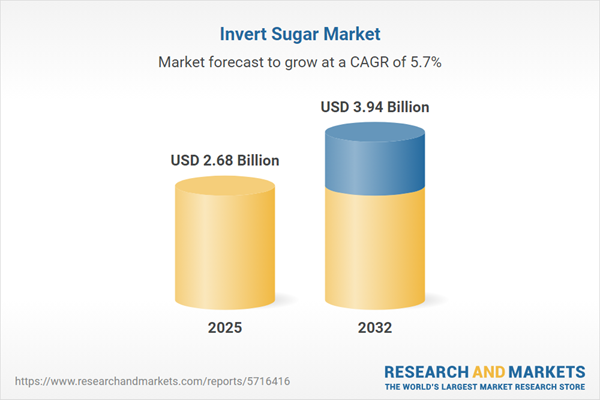Speak directly to the analyst to clarify any post sales queries you may have.
The invert sugar market is undergoing a period of transformation, driven by shifting consumer preferences, regulatory developments, and technical advancements that directly impact ingredient sourcing, formulation, and competitive positioning. Senior decision-makers in the food, beverage, and pharmaceutical sectors require a clear, actionable overview to inform resilient sourcing and product strategies in this evolving sector.
Invert Sugar Market Snapshot
The invert sugar market expanded from USD 2.54 billion in 2024 to USD 2.68 billion in 2025 and is projected to continue its trajectory at a CAGR of 5.65%, achieving USD 3.94 billion by 2032. This growth underscores the increasing relevance of invert sugar as manufacturers seek functionality, efficiency, and alignment with global clean label and health trends. Strategic responses to changing trade policies and evolving consumer requirements are reshaping competitive dynamics and presenting new opportunities for ingredient suppliers, food brands, and other channel stakeholders.
Scope & Segmentation
This research provides comprehensive coverage of the market's structural and operational elements, segmented by source, product form, application, distribution channel, and fructose concentration. Regional and company-level analysis delivers visibility into industry performance worldwide.
- Source: Beet-derived, cane-derived, and corn-derived invert sugar, each catering to specific supply chain and geographic needs.
- Product Form: Crystalline, liquid (including bulk and packaged in bottles or drums), and powder formats.
- Application: Diverse end-uses such as bakery (breads, cakes, pastries), beverages (alcoholic drinks, juices, soft drinks), confectionery (candies, chewing gum, chocolates), dairy, and pharmaceuticals.
- Distribution Channel: Food service, industrial, online, and retail channels (encompassing convenience stores, hypermarkets, and supermarkets).
- Fructose Concentration: High fructose types (including HFCS 42 and HFCS 55) and standard grades to accommodate varied functional and nutritional needs.
- Geography: In-depth analysis across Americas (North and Latin America), Europe, Middle East & Africa, and Asia-Pacific, with coverage of all major consumer and production hubs.
- Companies Covered: Extensive insights on Cargill, Incorporated; Archer-Daniels-Midland Company; Tate & Lyle PLC; Ingredion Incorporated; Tereos SCA; Südzucker AG; Roquette Frères; Nordzucker AG; E.I.D.-Parry (India) Ltd.; and Batory Foods, Inc.
Key Takeaways for Senior Decision-Makers
- Regulatory changes, such as enhanced labeling standards and sugar reduction policies, are turning compliance from a cost center into a competitive advantage for proactive players.
- Technological advances, including continuous processing and biocatalyst engineering, enable greater customization of ingredients, efficient operations, and improved yields for manufacturers.
- Growing demand for clean label, non-GMO, and natural sweeteners is reshaping product innovation across baked goods, beverages, and confectionery categories.
- Investment in sustainable sourcing and traceability initiatives strengthens stakeholder credibility and aligns with shifting retailer and consumer preferences.
- Strategic partnerships—spanning biotechnology providers, logistics specialists, and end users—are becoming essential for operational resilience, particularly amidst regulatory and trade uncertainties.
Tariff Impact on Global Sourcing and Cost Structures
Recent United States tariffs on imported invert sugar have reconfigured supply chains, compelling manufacturers to review sourcing frameworks and explore alternatives in tariff-exempt or domestic arenas. This policy shift has increased the urgency for diversified supplier relationships and local production capabilities. Collaboration with ingredient suppliers and logistics providers, as well as consideration of tariff engineering solutions, are now central to maintaining cost efficiency and supply continuity in the United States and affected trade partners.
Research Methodology & Data Sources
This report is underpinned by robust primary and secondary research, including executive interviews, industry surveys, and critical review of corporate filings, scientific literature, and regulatory databases. Findings were validated through data triangulation and benchmarking, with added rigor via peer expert workshops and established quality assurance protocols.
Why This Report Matters
- Guides strategic decision-making with granular segmentation, tariff analysis, and actionable recommendations specific to market dynamics and regulatory shifts.
- Equips business leaders to anticipate and mitigate risk while capitalizing on new growth areas, such as premium bakery or plant-based categories.
- Delivers verified insight into competitors, supply chain strategies, and developments in enzymatic and process technology.
Conclusion
The invert sugar market is adapting quickly to technological, consumer, and regulatory evolution. Decision-makers who invest in agility, compliance, and innovation are better positioned to thrive as industry boundaries shift. For tailored analysis and in-depth market opportunities, contact our team for the complete research report.
Additional Product Information:
- Purchase of this report includes 1 year online access with quarterly updates.
- This report can be updated on request. Please contact our Customer Experience team using the Ask a Question widget on our website.
Table of Contents
3. Executive Summary
4. Market Overview
7. Cumulative Impact of Artificial Intelligence 2025
List of Figures
Samples

LOADING...
Companies Mentioned
The key companies profiled in this Invert Sugar market report include:- Cargill, Incorporated
- Archer-Daniels-Midland Company
- Tate & Lyle PLC
- Ingredion Incorporated
- Tereos SCA
- Südzucker AG
- Roquette Frères
- Nordzucker AG
- E.I.D.-Parry (India) Ltd.
- Batory Foods, Inc.
Table Information
| Report Attribute | Details |
|---|---|
| No. of Pages | 187 |
| Published | October 2025 |
| Forecast Period | 2025 - 2032 |
| Estimated Market Value ( USD | $ 2.68 Billion |
| Forecasted Market Value ( USD | $ 3.94 Billion |
| Compound Annual Growth Rate | 5.6% |
| Regions Covered | Global |
| No. of Companies Mentioned | 11 |









